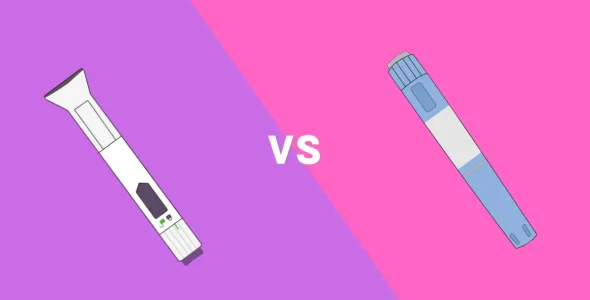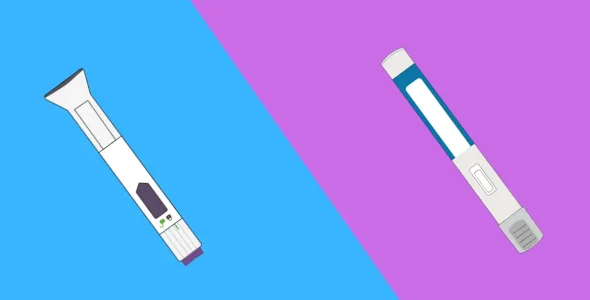Mounjaro side effects and how to avoid them
Find out the potential side effects of Mounjaro, from common to serious, and what you can do about them.
Key highlights
- Mounjaro is a subcutaneous tirzepatide injection that works on the GIP/ GLP-1 receptors in the body to reduce appetite and improve blood sugar levels.
- The U.S. Food and Drug Administration (FDA) has approved Mounjaro for type 2 diabetes management, but it is also widely used off-label for weight loss.
- Patients taking Mounjaro often experience side effects, such as injection site reactions, mild allergic reactions, and gastrointestinal issues, including nausea, vomiting, diarrhea, constipation, and abdominal pain. These side effects may vary among patients and everyone might not experience all of them.
- Some users also report serious side effects of Mounjaro, such as kidney disease, gallbladder problems, pancreatitis, hypoglycemia, worsening of diabetic retinopathy, severe allergic reactions, and suicidal thoughts.
- Common side effects of Mounjaro can be managed by lifestyle changes, but serious adverse reactions to the drug must be immediately reported to a healthcare provider for immediate medical action.
Mounjaro is an FDA-approved injectable subcutaneous drug prescribed for type 2 diabetes management and used off-label for weight loss. The active ingredient in Mounjaro is tirzepatide. It is a dual receptor agonist that mimics the action of GIP (glucose-dependent insulinotropic polypeptide) and GLP-1 (glucagon-like peptide-1) hormones. This twincretin action helps regulate blood sugar levels and reduce appetite by stimulating insulin secretion, reducing glucagon production, and delaying gastric emptying.
Mounjaro is the first and only GIP/ GLP-1 agonist drug for the management of type 2 diabetes, and it was approved by the FDA on May 13, 2022. Studies have shown that users taking Mounjaro with or without other diabetes management options reached an A1C of less than 7%. Zepbound, another tirzepatide-containing drug by Eli Lilly is FDA-approved and prescribed for chronic weight management in obese and overweight patients with at least one medical condition, such as high cholesterol, high blood pressure, or heart disease.
Individuals taking the medication might observe changes in their body, especially in the first few weeks. Starting this medication may cause gastric side effects, like Ozempic, Wegovy, and Saxenda. These adverse events include constipation, diarrhea, nausea, vomiting, and abdominal pain. Users also report other side effects of Mounjaro, such as injection site reactions, kidney problems, gallbladder disease, pancreatitis, diabetic retinopathy, and hypoglycemia. Patients allergic to the active ingredient or any excipient in the drug might also experience hypersensitivity reactions. Some of these side effects can be managed easily, whereas others might require professional medical advice. Report any unusual adverse events to your doctor immediately for adequate medical attention and treatment.
Most common side effects
GIP/GLP-1 drugs like Mounjaro reduce appetite by slowing down the digestive system, leading to gastrointestinal adverse effects in the majority of patients. Some of the most common possible side effects of Mounjaro are explained below.
Gastrointestinal issues (most frequent)
Mounjaro acts directly on your digestive system by delaying gastric emptying and increasing the transit time of food in the intestines. Healthcare professionals start Mounjaro at a low dose to minimize these side effects, but most users experience gastrointestinal side effects on starting the medication and raising the dose.
Nausea (18%): Nausea is the most common side effect of Mounjaro, reported by 12%, 15%, and 18% of patients using the 5 mg, 10 mg, and 15 mg dose, compared to 4% among the placebo group. Users usually experience nausea on the onset of medication or dose escalation every 4 weeks. Nausea caused by GLP-1 medications like Ozempic, Wegovy, Zepbound, and Mounjaro settles down as your body adjusts to the drug.
You can try the following to manage nausea when taking Mounjaro:
- Eat foods that contain water (soups, gelatin, watermelon, cucumber)
- Eat low-fat, bland foods, like rice, crackers, and toast
- Avoid fried or sweet items
- Eat boiled or grilled food items
- Avoid lying down after eating
- Eat slowly
- Take smaller meals
- Drink clear or ice-cold water
- Go out for fresh air
- Chew ginger for immediate relief
- Take an OTC antiemetic or antacid
If the condition does not get better in a few days, consult your doctor, and make sure to stay hydrated to avoid complications due to dehydration.
Diarrhea (16%): Diarrhea is another common side effect of Mounjaro experienced by 16.6% of individuals taking the 15 mg weekly dose. In clinical trials, 11.8% and 13.3% of the users taking 5 mg and 10 mg doses also reported diarrhea, respectively. It is important to stay hydrated and replenish your body fluids when suffering from diarrhea when using Mounjaro. Dietary adjustments like avoiding greasy and spicy food, caffeine, and alcohol may help manage the condition better. Consult your doctor immediately if the condition does not get better in a few days.
Vomiting (9%): Other than nausea and diarrhea, a large number of participants in Phase 3 Mounjaro trials reported severe vomiting. In trials, 9.1%, 5.0%, and 5.1% of the patients experienced vomiting while taking 5 mg, 10 mg, and 15 mg doses, respectively. Vomiting has been seen to be associated with renal failure as a result of prolonged dehydration, and may also require hemodialysis. If you experience persistent vomiting or signs of dehydration like dry mouth, fatigue, dizziness, loss of appetite, and yellow and concentrated urine, talk to your healthcare provider immediately.
Constipation (6.6%): While it is not among the top three side effects, loss of fluid due to vomiting can lead to constipation when using Mounjaro. In clinical trials, 5.9% of the users taking Mounjaro 5 mg have reported constipation, followed by 5.8% of those taking 10 mg, and 6.6% among the 15 mg group. Increasing water intake and adding fiber to your diet, such as whole grains, legumes, and cereals can help with constipation relief. You can also take prunes and increase physical activity to improve bowel activity. If these do not offer the desired relief, talk to a doctor or pharmacist regarding the use of the right laxatives for your needs.
Decreased appetite (3%): In clinical trials, 3% of the participants mentioned decreased appetite when taking Mounjaro. It is one of the primary effects of Mounjaro’s dual-incretin action that delays gastric emptying, making you feel fuller for a longer time and leading to a decreased appetite. It is important to eat healthy meals and ensure a nutrient-dense diet to stay healthy even when eating less. You can also consult a dietitian to draft a meal plan best suited to your needs.
Abdominal pain/discomfort (5%): Considering the GI-related side effects of Mounjaro, including indigestion, nausea, constipation, and diarrhea, patients also report abdominal pain and discomfort. Reported by approximately 5% of the patients taking Mounjaro, the pain may vary in severity. Abdominal pain may be an indication of an underlying health issue, such as gallbladder disease or pancreatitis. If you experience prolonged stomach pain, along with high fever and yellowing of skin, or with or without vomiting, report it to your healthcare provider immediately.
Indigestion (5%): Indigestion is another common side effect of the drug, resulting from delayed digestion and causing discomfort. Often indigestion may be a cause of nausea among patients taking Mounjaro. You can prevent indigestion by avoiding trigger foods, taking a walk after your meal, and not smoking. Take an OTC antacid for timely relief or talk to your doctor regarding the use of a suitable medication.
Other GI symptoms: Other than the above-mentioned adverse events, other reported gastrointestinal side effects of Mounjaro include eructation (burping) experienced by 3.3% of patients followed by flatulence (2.9%), abdominal distension (0.8%), and GERD (1.7%). These GI symptoms can be managed by eating a balanced diet, avoiding greasy foods, and adequate physical activity.
Injection site reactions (common)
Patients taking subcutaneous injections, such as Ozempic, Wegovy, Zepbound, and Mounjaro widely experience injection site reactions. Administering Mounjaro at the same spot every week can cause reactions, such as pain, irritation, itching, bruising, and rash at the site of injection. A reported 3.2% of individuals taking Mounjaro reported injection site reactions in placebo-controlled clinical trials.
You can prevent injection site reactions by rotating the injection site every week. You may use the same area (thigh/upper arm/abdomen) for administration, but select a different site within that area. Applying ice to the affected site can also help manage symptoms. Take an OTC antihistamine or talk to your doctor regarding the use of a suitable antihistamine cream or tablet. Also, do not inject Mounjaro into the skin with lumps, pits, bruises, scars, or tenderness.
Mild allergic reactions (less common)
People who are hypersensitive to the excipients (such as benzyl alcohol) or the active ingredient (tirzepatide) in Eli Lilly’s Mounjaro may experience allergic reactions. The symptoms of a mild allergic reaction include rash, itching, flushing, or sneezing. Some users may get severe allergic reactions on the use of Mounjaro, including widespread skin rash, trouble breathing and swallowing, confusion, restlessness, and dizziness. Mild hypersensitivity reactions do not require immediate help; an OTC antihistamine can help alleviate symptoms. However, if you experience a serious allergic reaction, immediately stop taking the medication and reach out for emergency medical help.
Other common side effects
Mild increase in heart rate and fatigue are among the lesser prominent but common side effects of Mounjaro. In trials, 1.7% of users taking Mounjaro 15 mg reported an increase in resting heart rate. Studies showed that Mounjaro caused an increase of 2 to 4 beats per minute on average. It is one of the long-term side effects of the medication that may require prolonged treatment. Patients with cardiac conditions must inform their doctor to avoid further complications.
Some people also report fatigue from taking the medication for a long period. It may be due to vomiting, nausea, and a decrease in appetite because of Mounjaro’s mechanism of action. A healthy diet and moderate physical activity help avoid fatigue and tiredness.
Serious side effects (rare)
Other than the common side effects of Mounjaro, patients may experience serious side effects. These adverse events are not as common as gastrointestinal side effects but can be severe and long-term. If you experience any of the following side effects, talk to your healthcare professional right away. They might ask you to stop the medication or provide a suitable treatment regimen.
Boxed warning: Risk of thyroid tumors (including cancer)
GLP-1 and GIP/GLP-1 agonist drugs come with a black box warning for thyroid c-cell tumors by the FDA. Tirzepatide drugs, such as Mounjaro, have been seen to have a dose-dependent and treatment-duration-dependent increase in thyroid c-cell tumors including cancer in rats during a two-year clinical study. However, the relation between tirzepatide use and c-cell tumors has not been established in humans; it is unknown whether the drug causes thyroid c-cell tumors, including MTC, in humans. Doctors suggest not using Mounjaro if:
- You or someone in your family had Medullary Thyroid Carcinoma (MTC)
- You have Multiple Endocrine Neoplasia Syndrome type 2 (MEN 2)
Contact your doctor if you observe a lump or swelling in the neck, trouble swallowing, hoarseness, difficulty swallowing, or shortness of breath for immediate diagnosis and treatment.
Pancreatitis (inflammation of the pancreas)
Pancreatitis refers to the inflammation of the pancreas, observed in 13 patients (0.2%) in clinical trials. Acute pancreatitis, including non-fatal and fatal hemorrhagic or necrotizing pancreatitis, has been observed in patients using GLP-1 receptor agonists. It is not known if users with a history of pancreatitis are at a higher risk of pancreatitis on taking Mounjaro. Patients experiencing symptoms of pancreatitis including nausea, fever, increased heart rate, and severe abdominal pain (radiating to the back) with or without vomiting, immediately stop the medication and talk to your doctor.
Severe digestive problems
Gastrointestinal issues, such as nausea, constipation, vomiting, abdominal pain, and diarrhea are quite common on starting the medication and dose escalation. Most of these issues are mild and go away on their own, but some problems, like vomiting, can lead to serious health problems. Persistent vomiting and diarrhea, if not managed timely, can cause dehydration which can lead to acute kidney injury (AKI) that may require dialysis. Common signs and symptoms of acute kidney failure are weakness, less urine output, confusion, swelling in feet and legs, headache, and nausea. Patients experiencing these symptoms must talk to their doctor to ensure timely diagnosis and treatment.
Hypoglycemia (low blood sugar)
Hypoglycemia is a rare side effect of Mounjaro, usually experienced by users taking another medication for diabetes management. An increased risk of hypoglycemia was seen with concomitant use of sulfonylurea or basal insulin with Mounjaro. SURPASS-4 trials showed that severe hypoglycemia occurred in 0.5%, 0.0%, and 0.6% of patients when Mounjaro 5 mg, 10 mg, or 15 mg, was co-administered with a sulfonylurea. Eli Lilly suggests reducing the dose of insulin or insulin secretagogue when taking Mounjaro to avoid hypoglycemia in patients with type 2 diabetes.
Symptoms of low blood sugar levels include:
- Tremors
- Tiredness
- Dizziness
- Weakness
- Confusion
- Irritability
- Sweating
- Hunger
- Fast heartbeat
- Blurred vision
- Slurred speech
- Seizures
If you experience the above-mentioned signs and symptoms, stop the medication and talk to your doctor immediately for quick action.
Gallbladder issues
In clinical studies, 0.6% of participants on Mounjaro reported symptoms of gallbladder disease, while the placebo group did not have any gallbladder-related issues. Acute gallbladder problems such as cholecystitis and cholelithiasis have been reported in GLP-1 receptor agonist drug trials and post-marketing. Mounjaro users have reported acute cholecystitis (inflammation of the gallbladder) and biliary colic (gallstones) on using the medication. Symptoms of gallbladder problems include sudden severe pain in the upper right part of the abdomen (may radiate to the back or right shoulder and last for up to hours), yellowing of your skin/ eyes (jaundice), clay-colored stools, decreased appetite, and high fever with chills. Users experiencing any of these symptoms must consult their healthcare provider at the earliest.
Acute kidney injury
Besides gallbladder disease, acute kidney disease and worsening of chronic renal failure are also reported by patients taking Mounjaro for type 2 diabetes management. It typically occurs from severe dehydration as a result of prolonged vomiting or diarrhea, and may sometimes require hemodialysis. Patients suffering from acute renal failure may have symptoms like decreased urination, shortness of breath, tiredness, weakness, swelling in legs, ankles, and feet, chest pain or pressure, nausea, confusion, and seizures. It is important to keep yourself hydrated and replenish bodily fluids to prevent dehydration and related kidney problems.
Talk to your doctor if you observe any of the symptoms of acute kidney injury and monitor renal function when starting or increasing the dose of Mounjaro, especially if you have prolonged vomiting and diarrhea.
Severe allergic reactions
Mild allergic reactions do not require immediate medical help but severe allergic reactions must be reported to the doctor immediately. In case you are hypersensitive to one or more ingredients in the brand name drugs, Mounjaro or Zepbound, you might experience severe allergic reactions while taking the medication. Serious allergic reactions (anaphylaxis) can be identified by rash, swelling, difficulty breathing, trouble swallowing, fever, increased heart rate, swelling of the face/lips/mouth/tongue/throat, throat tightness, hives, itching, dizziness, joint pain, stomach cramps, and fainting.
If you experience these reactions while taking your Mounjaro dose, stop the medication immediately and talk to your doctor for urgent medical care.
Vision changes (diabetic retinopathy)
Improvement in blood glucose levels on taking Mounjaro has been seen to worsen diabetic retinopathy among patients. It may require treatment or lead to vision loss if not managed timely. Mounjaro users experiencing changes in vision, including blurred vision, loss of color vision, floaters, black spots, and lines in vision must inform their healthcare provider immediately to prevent further complications. Mounjaro has not been studied in patients with diabetic macular edema, non-proliferative diabetic retinopathy requiring acute therapy, or proliferative diabetic retinopathy.
Potential increased risk during surgery and anesthesia (pulmonary aspiration)
There have been rare reports of pulmonary aspiration during generation anesthesia or deep sedation when undergoing elective surgeries or procedures. This occurs due to the drug’s GIP/ GLP-1 action that delays gastric emptying, resulting in residual gastric content despite reported adherence to standard preoperative fasting procedures. It increases the risk of food or liquid entering the lungs during the operative procedure. People taking Mounjaro must inform their doctor before a planned surgery that requires deep sedation or general anesthesia. The benefits and risks must be considered for such procedures when the patient is on a tirzepatide drug.
Long-term side effects and safety concerns
Other than common GI side effects, individuals using Mounjaro for type 2 diabetes management have reported long-term side effects, such as severe gastrointestinal issues, kidney problems, gallbladder disease, and pancreatitis, which may require long-term treatment.
There have also been reports of suicidal ideation and mood changes in patients taking weight loss drugs, such as GLP-1 agonist receptors. Healthcare professionals must consider the risks and benefits before initiating or continuing Mounjaro therapy in patients with suicidal thoughts or a history of suicidal attempts. If you have thoughts of harming yourself or find your mental health to be worsening on Mounjaro use, talk to your doctor right away.
Adverse gastrointestinal reactions, related to impaired gastric emptying, including severe gastroparesis have been observed in some users. Sometimes, the drug may delay stomach emptying such that the food might form hard masses in your stomach, making it difficult to pass the bowel. Symptoms of gastroparesis include indigestion, bloating, nausea, vomiting, acid reflux, loss of appetite, feeling full quickly, upper belly pain, and constipation. Ignoring the condition can lead to a life-threatening blockage in your gastrointestinal tract. It is important to monitor and modify the dose or discontinue the medication in patients who develop severe gastroparesis during therapy.
The medication has been seen to increase the heart rate in some users, which may require ongoing treatment. Studies have shown an increase of 2-4 beats per minute, making it important to monitor changes in heartbeat and design a treatment regimen accordingly. Users also mention weight loss plateaus and metabolic adaptation on taking the medication for a long time, leading to no further weight loss. Your body might adapt to the changes and start managing efficiently with the reduced-calorie diet. This can be overcome by changing the type of physical activity in your routine and burning more calories until you start seeing a difference in your body weight again.
Thyroid c-cell tumors have not been observed in humans taking Mounjaro, but animal studies have shown the risk of cancer by taking tirzepatide. Individuals with MEN 2 or MTC must not take Mounjaro, and report symptoms like lump or swelling in the neck, changes in voice, difficulty swallowing or breathing, and throat pain to the doctor immediately.
Who should not use Mounjaro
Mounjaro has been contraindicated in numerous conditions to prevent life-threatening adverse events in people who are more susceptible. It is contraindicated in people with:
- Personal/family history of medullary thyroid cancer (MTC)
- Multiple Endocrine Neoplasia syndrome type 2 (MEN 2)
It is also not recommended in pregnancy and breastfeeding due to insufficient data and unknown risks. No clinical trials have been conducted on pregnant or lactating females. Women who plan to get pregnant are suggested to stop the medication at least one month before pregnancy.
Mounjaro has not been studied in patients with severe gastroparesis and caution is advised when prescribing the drugs to such patients. People with a history of gastroparesis are recommended to inform their doctor of the condition.
Individuals hypersensitive to any of the inactive or active ingredients in Mounjaro must inform their doctor of the allergy to prevent severe reactions. In case you observe an allergic reaction after taking the medication, stop it and talk to your doctor right away.
Mounjaro users taking another GLP-1 drug, or diabetes medicines, such as insulin, or insulin secretagogues (e.g., sulfonylureas) must mention the use of these medications to their healthcare provider. They will reduce the dose of the medication if needed to avoid the risk of severe hypoglycemia. In case you experience the symptoms of hypoglycemia, such as dizziness, blurred vision, rapid heartbeat, shaking, sweating, and fainting, report them to your doctor for immediate medical help.
How to manage Mounjaro side effects
Using Mounjaro comes with a risk of numerous common and rare side effects, but you can control most of them efficiently. Here’s how you can manage Mounjaro’s side effects while taking the medication for type 2 diabetes management or weight loss.
- Communication with your healthcare provider: Any changes in your body on using Mounjaro, including mild side effects, must be reported to your healthcare practitioner immediately. Some side effects might indicate a serious health issue or ignoring them may lead to a long-term problem. Your doctor will provide you with the right treatment or management plan for the problem.
- Hydration: Keeping yourself hydrated during Mounjaro therapy can help replenish your body, especially with gastrointestinal side effects, such as vomiting and diarrhea. It also helps prevent complications, including acute kidney failure that might arise from prolonged vomiting and fluid loss.
- Dietary modifications: Dietary modifications, like eating small, bland meals, avoiding greasy foods, caffeine, and alcohol, and taking a walk after eating can help prevent indigestion, nausea, flatulence (farting), and eructation (burping).
- Over-the-counter medications: If you experience nausea, heartburn, or mild allergic reactions, take over-the-counter antacids (for nausea), antiemetics (for vomiting), and antihistamines (for allergic reactions) to manage these symptoms better. It is better to talk to a doctor or pharmacist before selecting a medication for your condition.
- Injection technique: When injecting the Mounjaro pen, clean the area properly and follow the instructions shared by Eli Lilly or demonstrated by your doctor. Make sure to rotate the site of injection every week, even if injecting in the same area.
- Lifestyle adjustments: Other than dietary changes, adding physical activity to your routine promotes facilitated weight loss with Mounjaro and helps manage blood glucose more efficiently. Incorporate yoga, brisk walking, swimming, or strength training into your routine at your preferred pace. Physical movement, walking, and Qigong can help with constipation due to fluid loss from prolonged vomiting or diarrhea during Mounjaro therapy.
- Symptom tracking: If you experience the common symptoms of Mounajro that do not require immediate intervention, keep a record of these events and their duration to discuss with your doctor at the next appointment. It can help prevent serious, long-term issues that might adversely affect your vital organs.
Nausea/vomiting
Nausea is the most common side effect of Mounjaro and can be managed by:
- Eating small, bland meals, such as rice and toast
- Avoiding fatty and greasy foods, and opting for grilled or boiled food items
- Eating no more as soon as you feel full
- Staying hydrated
- Adding water-rich foods to your diet, such as soups, watermelon, cucumbers
- Going out for a walk after your meal
- Avoiding alcohol and fizzy beverages with meals
- Chewing on ginger for immediate relief
If the nausea does not go away with these tips, talk to your doctor and ask them to suggest an over-the-counter anti-nausea medication.
Diarrhea/constipation
Many individuals complain of diarrhea while taking Mounjaro, while some may experience constipation because of changes in the digestive mechanism. Increasing fiber intake gradually, by adding fruits (prunes, apples, bananas), green vegetables, legumes, and whole grains to your diet. Avoiding high-fat and dairy products can also help relieve diarrhea when using Mounjaro.
Injection site reactions
Injection site reactions can be prevented by rotating the injection site, even when administering the injection in the same location every time. Whether you inject the subcutaneous tirzepatide injection into your thigh, abdomen, or upper arm, always select a different injection site each time you administer the medication. If you feel redness or swelling at the site of injection, use a cold compress within 48 hours of injection for relief.
When to seek medical help
Most of Mounjaro side effects can be managed with dietary changes, lifestyle modifications, or OTC medications, but some issues need immediate medical help, such as:
- Severe abdominal pain: Abdominal pain should subside as your body gets familiar with the medication, but prolonged abdominal pain (with or without vomiting) can be a sign of pancreatitis and must be reported to your healthcare professional immediately.
- Persistent vomiting: Continuous vomiting on Mounjaro use can lead to dehydration and eventually cause kidney damage. Persistent vomiting has been associated with Acute Kidney Disease that may require dialysis, and your doctor will provide a suitable treatment regimen for continuous vomiting.
- Allergic reaction: Individuals allergic to one or more components in Mounjaro may experience a mild or serious allergic reaction. If you experience symptoms like rash, itching, flushing or sneezing, an antihistamine can help. However, symptoms of a serious allergic reaction include swelling on your face, hives, trouble breathing, confusion, dizziness, increased heart rate, and fainting. Talk to your healthcare provider immediately in case of a serious allergic reaction.
- Unusual lumps in the neck: There have been no reports of thyroid tumors in humans with tirzepatide use, but it has been observed in rodents during clinical studies. Lumps or pain in the neck, and breathing or swallowing issues, must be reported to the doctor immediately for timely diagnosis and adequate treatment.
Mounjaro vs. other GLP-1 drugs: Side effects comparison
Other than Mounjaro, people use other GLP-1 agonist drugs, including Ozempic, Wegovy, and Trulicity to lose weight and regulate their blood glucose levels. The side effects of these drugs are similar but may vary slightly.
- Ozempic (semaglutide): Ozempic is a semaglutide drug, approved for type 2 diabetes management, but often used off-label or weight loss. The side effects of Ozempic are similar to Mounjaro, including nausea, vomiting, and diarrhea, but the latter may have stronger appetite suppression for better results.
- Wegovy (semaglutide for weight loss): Wegovy is another semaglutide injection by Novo Nordisk having semaglutide as the active ingredient. It is prescribed for weight loss in obese and overweight individuals. The drug mainly focuses on weight loss and has a lower hypoglycemia risk in non-diabetic patients, compared to Mounjaro. It may also show results slower than Mounjaro which has a double incretin action.
- Trulicity (dulaglutide): Trulicity contains a different GLP-1 agonist, dulaglutide, that works similarly to semaglutide. It is generally prescribed to patients who need less intensive GLP-1 therapy. Trulicity has milder side effects in comparison to Mounjaro and is less potent for weight loss.
FAQs about Mounjaro side effects
Do side effects get better over time?
Yes, most side effects, including gastrointestinal side effects get better after a few weeks as your body adjusts to the medication. However, serious side effects, such as severe allergic reactions, changes in vision, hypoglycemia, prolonged vomiting, and abdominal pain must be reported to the healthcare provider. The gastrointestinal side effects may appear again when your healthcare provider increases the dose.
Can I drink alcohol on Mounjaro?
Lilly does not have information on the use of alcohol with tirzepatide; healthcare professionals advise caution with alcohol when taking Mounjaro for diabetes management. Alcohol is a calorie-dense drink and may influence weight loss and worsen nausea. It has also been seen to cause hypoglycemia, increasing the user’s risk for severe hypoglycemia, especially in patients with type 2 diabetes.
Does Mounjaro cause hair loss?
Hair loss is not among the reported side effects of Mounjaro, but sudden weight loss may lead to loss of hair in patients using glucagon-like peptide-1 (GLP-1) agonists.
Does Mounjaro make you tired?
Mounjaro acts on the GIP and GLP-1 receptors in the body to reduce appetite, which may cause fatigue and weakness in some people, making them feel tired. It is suggested to take a healthy diet and perform moderate physical activity to prevent fatigue and tiredness.
Bottom line
Mounjaro (tirzepatide) is a subcutaneous injection approved for type 2 diabetes management but is also used off-label for weight loss. Tirzepatide reduces appetite and promotes weight loss by acting on the GIP/GLP-1 receptors in the body that delay stomach emptying and regulate blood sugar levels.
Starting Mounjaro can cause numerous common gastrointestinal side effects, such as vomiting, nausea, constipation, diarrhea, and abdominal pain. These side effects of Mounjaro are mild and temporary and resolve after a few weeks.
However, some side effects, such as allergic reactions, kidney problems, gallbladder disease, pancreatitis, hypoglycemia, increased heart rate, and worsening of diabetic retinopathy are rare but require immediate medical attention. The drug also comes with a boxed warning for c-cell tumors (studied in rodents).
In case of serious side effects, stop the medication and report the symptoms to your doctor immediately, and always consult your healthcare provider before starting or increasing your dose.










